Hi there “Process Automation” fans,
Welcome to a new installment of “Process Automation” tips.
Last week we installed RabbitMQ; This week we dive into the OpenText JMS connector for a second time (read here about our first time with Apache ActiveMQ) to boost our loosely coupled experiences. Almost every project has a request for this (especially from “Architectural roles”)…That’s also why I wanted to spend time again exploring it! Just to provide a solid answer to the request.
Let’s get right into it…
Boot up your OPA machine and make sure your RabbitMQ service is up and running as explained last week. Once both services are up and running, you need to make sure to login into the shared ‘/system’ space with your ‘sysadmin’ account. From this space we will deploy 2 new platform packages from the ‘Application Deployer’ artifact:
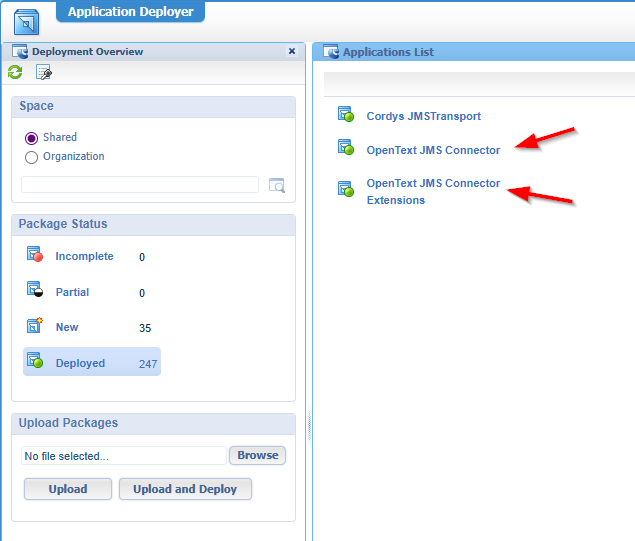
In my screenshot they are already deployed, but you can follow the deployment wizard yourself…Not a hard task to do!
After this deployment I restart my TomEE instance sudo systemctl restart tomee as I see some deliveries (JAR’s) dropping off on the server as well! Now move to your own specific organization with your own developer/administration account. Open the ‘User Manager’ artifact and attach yourself to a new role called ‘JMS Connector Administrator’:

With this new role applied, you will now see a new artifact passing by with the brilliant name ‘JMS Connector Configuration’. Open it and create yourself a new configuration with input from the below screenshots:

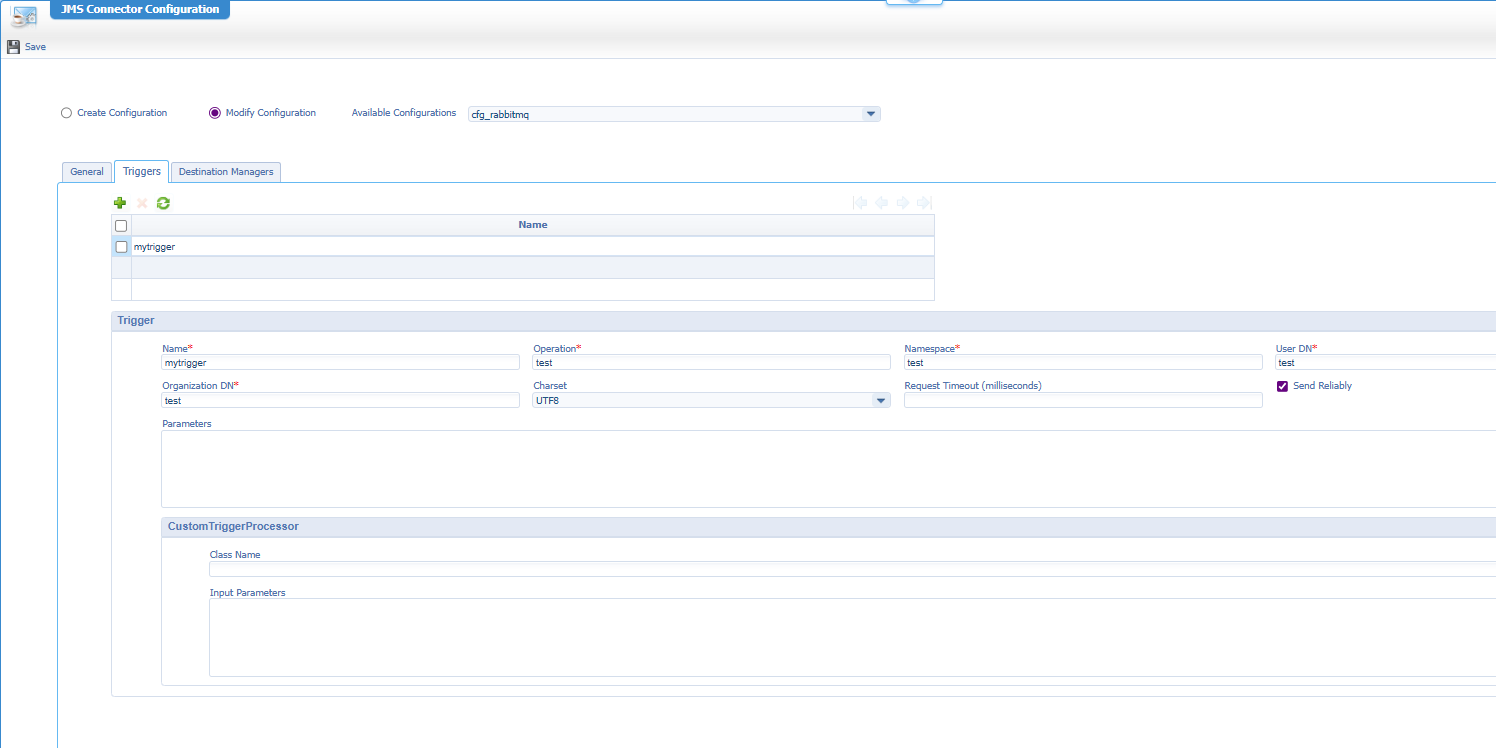
We set the values now to test, but we’ll adapt when needed to correct values…This is always good practice to during R&D!
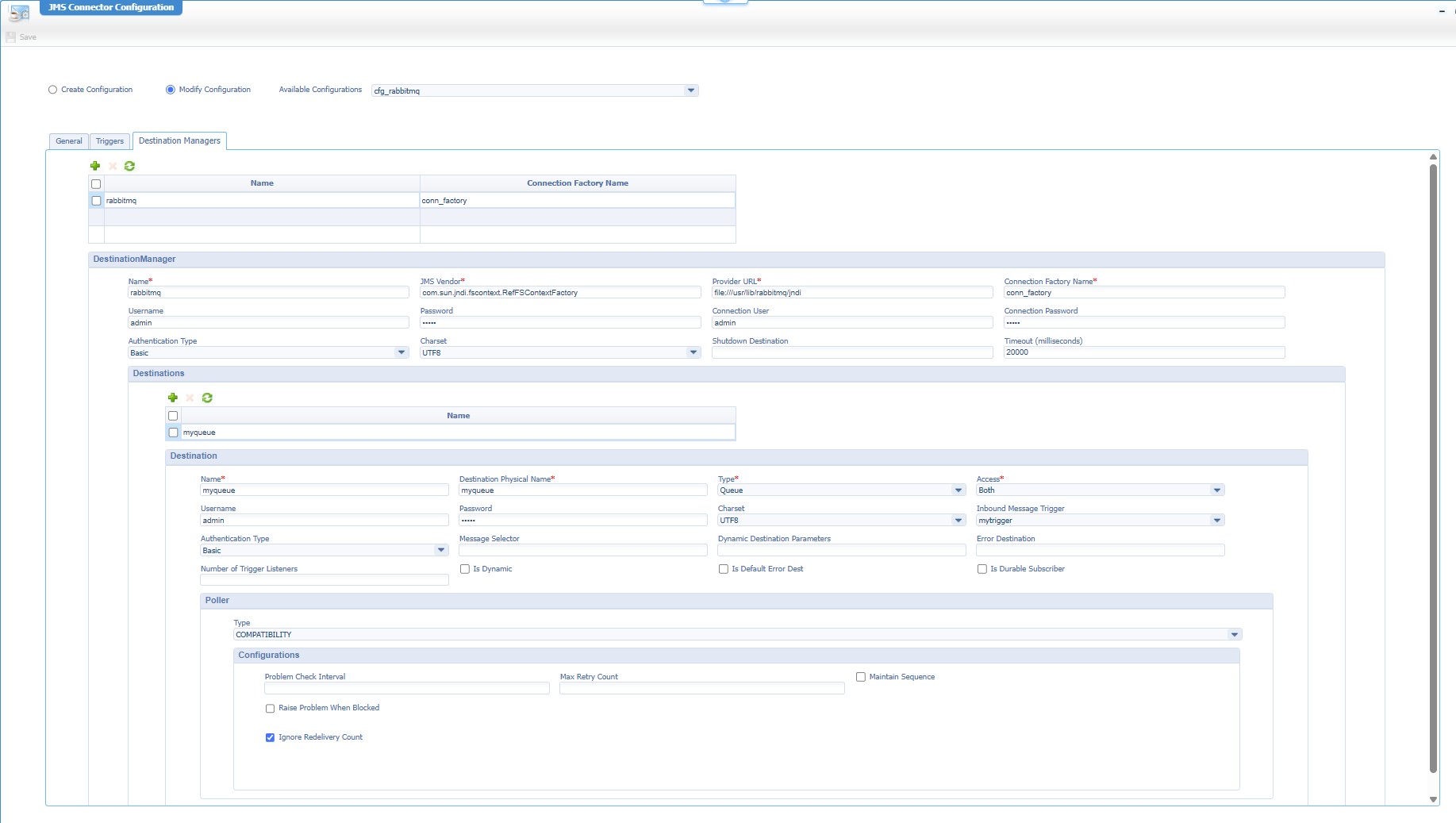
Notes so far:
- The JMS configuration is called
cfg_rabbitmq…It’s saved on the XMLStore/OpenText/JMSConnector.- The provider URL value
file:///usr/lib/rabbitmq/jndi/is from the OPA administration documentation. Create that directory yourself withmkdir /usr/lib/rabbitmq/jndi, and make sure the TomEE usertomcat:tomcathas sufficient permission to it.- Use this for JMS vendor value
com.sun.jndi.fscontext.RefFSContextFactory(part offscontext.jarandproviderutil.jar…see further down in this post). It’s a class for reading the JNDI.bindigsfile where you define the ‘Connection Factory Name’!
This is the content for the JNDI binding details where you need to match your factory name and your queue name: vi /usr/lib/rabbitmq/jndi/.bindings
1 | =com.rabbitmq.jms.admin.RMQConnectionFactory |
Make sure to use the correct port
5672; The OPA admin documentation quotes about port5673! You can verify this port with commandsudo rabbitmqctl status
The service container configuration part
The next step is to create a new service container of type ‘OpenText JMS Connector’ in the ‘System Resource Manager’ artifact. Use this as input to go through the wizard:
- Groupname:
sg_jms- Add the 2 available webservice interfaces
- Service container name:
sc_jms- You can let it start automagically
- Connect it to the OS process…For ActiveMQ, we didn’t do this, but reading the documentation about “Configuring service containers for reliable messaging” it looks like the better option.
- Make sure to set the JRE Configuration tab to this specific JAR file (use
:for Unix, and;for Windows):1
/opt/opentext/ProcessAutomationCE/defaultInst/components/jmsconnector/lib/fscontext.jar:/opt/opentext/ProcessAutomationCE/defaultInst/components/jmsconnector/lib/providerutil.jar:/usr/lib/rabbitmq/lib/rabbitmq_server-3.13.7/lib/rabbitmq-jms-3.5.0.jar:/usr/lib/rabbitmq/lib/rabbitmq_server-3.13.7/lib/amqp-client-5.26.0.jar:/opt/tomee/apache-tomee-plus-10.0.0/lib/slf4j-api-2.0.16.jar
- Select the configuration in the final step of the wizard:
cfg_rabbitmq
You can download those dependent RabbitMQ JARS here and upload them to the correct location on the VM:
Start the new JMS service container and fingers crossed it’ll be green!? Well, mine is, but with a penalty of an endless loop on errors in the Application_Server.xml logfile of OPA with this stacktrace:
1 | <log4j:event logger="com.opentext.jmsconnector.poller.BaseJMSPollerThread" timestamp="1761560902071" level="ERROR" thread="jms-compatibility-poller-1 of destination rabbitmq.myqueue"> |
What could be wrong here? Is it the queue type? Is it my “Hello world…” test-message? Did we miss of small configuration part (which is probably the case!?)…Ohw boy! It’s time for a remote debug R&D session!
Interesting note! Converting the hex-value (from the stacktrace)
48656C6Cto text givesHell…The start of my test-messageHello world...! Looks to me like it starts to swallow, but spits it out again because of invalidity.
…
The R&D outcome…
First I “purged” the message queue from within RabbitMQ; That removed the errors, and the service container starts with a green icon! So, it’s my message! Time to #RTFM
These are the “small letters” for RabbitMQ is relation to OPA:
- Only Classic Queue Types are supported
- RabbitMQ JMS topic selector plugin supports topic selectors. It does not support message selectors
- “Disable Message Selectors” configuration must be disabled for RabbitMQ as it does not support the message selectors
- For RabbitMQ, provide the folder path of the JNDI bindings file
- If the “Disable Message Selectors” is not disabled (so it’s enabled? so, it has a checkmark…Or NOT!?), then
JMSXDeliveryCountmust be set to 1 - Interfaces of XA transactions support are not implemented. The distributed transactions are not supported
So, do we need to enable or disable this option?

If I read correct with my binary/logic brains…It should NOT have a checkmark! BUT have a comment below as it’s terribly documented!
Eventually I suspect my message, and wrote my own JMS client in Java for sending a message to my queue.
This seems to send a “different” but valid message (with header content_type: application/octet-stream):
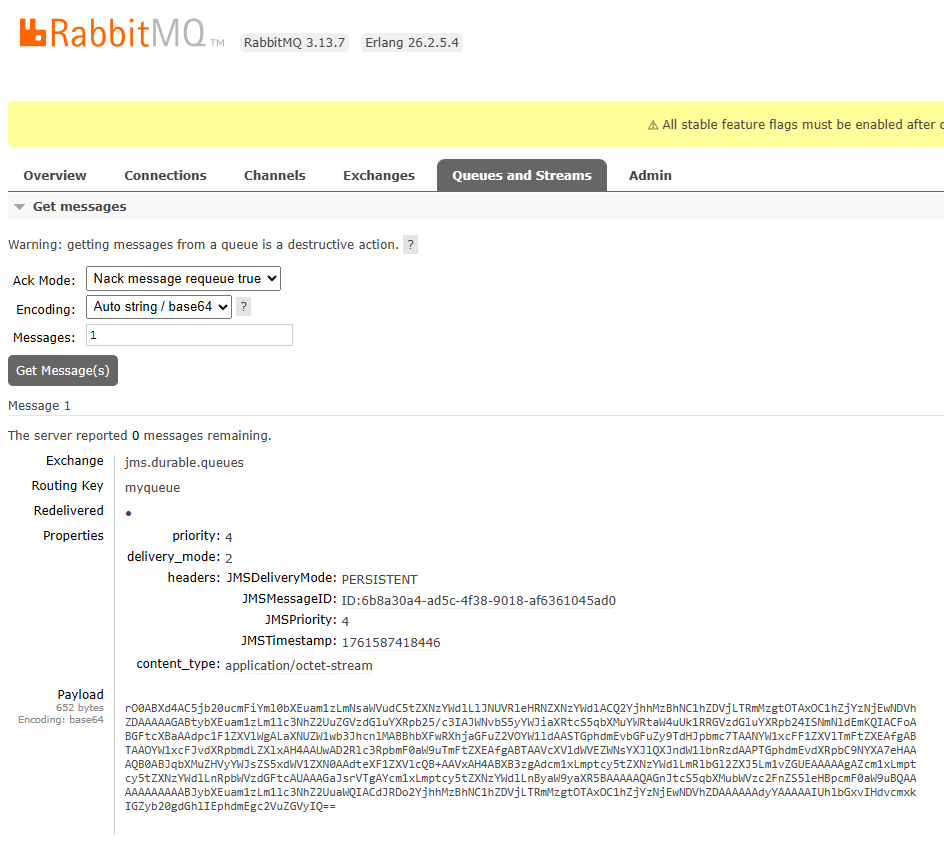
Restarting the JMS connector swallows this message like candy (with an aftertaste for later!)! 🍬
Before I forget! I detached (or “unbind”) the RabbitMQ exchange
myexchangefrom the queue. After this it also works better, and my queue is bound to the defaultjms.durable.queuesexchange.
This is what I also found about “jms.durable.queues”: JMS-emulation layer (created by the RabbitMQ JMS adapter to behave like a Java Message Service broker). Sounds like the OPA way of calling JMS!
…
So far, my OPA JMS service container is green. I’ve purged all the message in the queue as we need to move on, exploring next territories.
First OPA service call
I guess it’s time to fire our first ‘SendMessage’ SOAP call. Open the artifact ‘Web Service Interface Explorer’ and have a look for namespace http://schemas.cordys.com/jmsconnector/operations/3.0.
Time to make a test request on ‘SendMessage’ like this:
1 | <SOAP:Envelope> |
This is a response you can expect:
1 | <data> |
You can now validate this message in RabbitMQ:
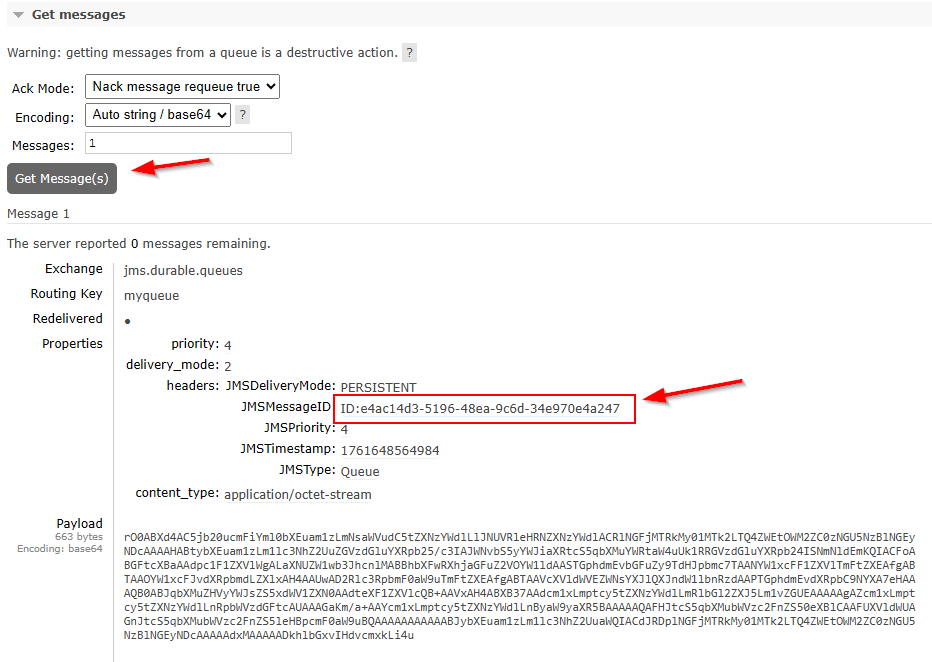
If you want to receive this message again, do a call like this:
1 | <SOAP:Envelope> |
With a response:
1 | <data> |
HOWEVER,…We see that RabbitMQ is sooooo blazing fast that our send message is directly picked up again by the poller of our JMS service container, which instantly wants to start our trigger! Yes, that’s the one with all the test values which I also see passing by in the logging: Error creating soap operation test:test in organization test for user test…AHA!
Triggers
Yes, what about those triggers we saw in the screenshots above!? What can we do with these so-called “Inbound Message” triggers? Well, I made a first example with test values, but we can make it better with an example like this:

Have a look in the documentation as it’s even possible to pass data (like
{$inputmessage}) from the JMS message as input to that BPM!!
Restart the JMS service container after this change. Now send a message via SendMessage, and you instantly see our trigger doing its job with a BPM instance in the PIM artifact:

It’s magic…And it also works slightly different from what we saw with ActiveMQ managing those messages!
…
I also played with this polling mechanism:

However, it’s again different from ActiveMQ as I still see a direct instance of my BPM passing by in the PIM after sending a new message. Well, it’s not that big of a problem; My loop is closed…I can send a message from an external party to RabbitMQ, the OPA JMS service container picks it up, removes the message from the queue, and starts my advanced BPM logic!
I call it a party! 🥳
That is a queuey(?) “DONE” where we all saw (again!) the power of a loosely coupled JMS principle to place messages on a queue and getting them off the queue via the FiFo technique. We (at least I) will have great benefits on this knowledge for my current project where the queue will be shared with a second external consumer where we want reliable message sharing across both platforms! Have a good weekend and I see you in the next one…🍺
Don’t forget to subscribe to get updates on the activities happening on this site. Have you noticed the quiz where you find out if you are also “The Process Automation guy”?


